#GameMastery
Explore tagged Tumblr posts
Text
🎮 Want to Create Your Own Roblox Game? Here’s How! 🚀 Roblox isn’t just for playing—it’s a platform where you can build your own game and even earn money from it! Follow this step-by-step guide to bring your ideas to life in Roblox Studio.
🔗 Read now: https://pixgamego.com/game-mastery/roblox-game/
0 notes
Text
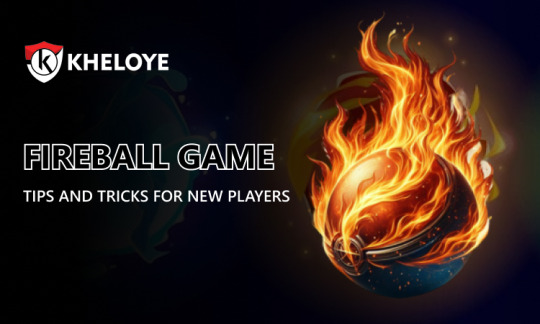
Read essential tips and tricks for mastering the Fireball Game! This guide helps new players improve their skills, learn strategies, and dominate gameplay. From beginner basics to advanced techniques, gain the knowledge you need to succeed and enhance your gaming experience in Fireball Game.
#FireballGame#GamingTips#FireballGameTips#NewPlayerGuide#GamingTricks#FireballGameStrategy#BeginnerGamingTips#GameMastery#FireballGameGuide#GameTipsAndTricks#ImproveYourGameplay#FireballStrategies#GamingCommunity#FireballBeginners#ProGamingTips#GameSkills#FireballProTips#GamerLife#GameOn#GamingSuccess
0 notes
Text
#HamsterKombat#DailyMiniGame#GamingTips#GameStrategy#MobileGaming#HamsterKombatGuide#LeaderboardChallenge#GameMastery#HamsterGames
0 notes
Link
Online gaming has exploded in popul... #GameMastery #GamingTips #MasteringOnlineGaming #onlinegaming
0 notes
Text
Ready to dominate Screw Puzzles like a pro? Our guide offers expert tips and techniques to help you conquer challenges, achieve precision, and rule the game!
#ScrewPuzzleMaster#PuzzleSolving#BrainTeasers#GameStrategy#MindGames#ProblemSolving#PuzzleChallenge#GameSkills#GameMastery#LogicPuzzles
1 note
·
View note
Link
0 notes
Text
There’s some XP To Level 3 video, I think one of the “gigachad DM” series? I usually like XPTL3 overall, but this one part rubbed me the wrong way. It was a group doing character pitches for a Curse of Strahd campaign, and the last player says he wants to be an Adult Red Dragon. There’s discussion (“do you want to be a cursed/transformed dragon?; No”), but when the rest of the players say that they’re okay with having this party member that will severely alter how they interact with NPCs and greatly overshadow them in combat, the DM goes “okay, fine, if you’re all okay I can make it work”.
And like. I don’t know, I think the “chadlier” response in this case would be to veto. Maybe the bit is that this DM is so crazy good that they can just alter the proposed game to accommodate it without any trouble, but it still bugs me. Regardless of if the other players are fine with it, I think “gigachad” practice in this case would be to stand up for your own enjoyment. You are a player as well, and if you have pitched Curse of Strahd, I’d imagine you’re looking forward to horror vibes and dark perils and whatnot, which are pretty incongruous with a full ass dragon in the party - to say nothing of having to significantly rewrite the module and especially the combat encounters. Bending over backwards and sacrificing your own enjoyment to accommodate one inconsiderate player isn’t gigachad shit actually, IMO.
I’m definitely reading into it too deeply but still.
With regards to this post, I think the people saying "a good DM could make it work" do have answer to the question of "but why would they?" But their answer is, basically, because it's a lot of work.
There are a lot of what I would call "hustle culture DMs," people for whom the amount of work and effort they put into their campaign is intrinsically good, proof of them being good DMs. Doing less work, even if it accomplished an equally good (or better!) end result, would be bad. The point is the grind, that's what proves how good they are.
And like hustle culture bros, they're mostly full of shit, they're not actually doing what they advocate for, and those who are doing it are burning themselves out for absolutely nobody's benefit. You should treat people telling you that "a good DM could make it work" the same way you treat people telling you to sleep four hours a day so you can focus on your side hustles.
#ttrpg#tabletop roleplaying#tabletop gaming#dnd#d&d#dungeon master#Gamemastery#Gorilla Straylight Complains#I’m sorry but GMs are not computers#the idea that we have to accommodate whatever the players want is nonsense#it’s why nobody wants to be a GM#and I *know* there’s MFs who will see this and call me a lame#or compare me unfavourably to what they would do or what their DM does#and sure to each their own#xp to level 3
304 notes
·
View notes
Text
Book Review: 1E GameMastery Guide
And it’s time for another review of various books in the Pathfinder system, this week starting with the GameMastery Guide (yes, the capital M in the middle is accurate).
Now, those who remember the previous reviews might immediately ask. “But wait? Didn’t Pathfinder 1e merge the Player’s Handbook and Dungeon Master’s Guide of the game it was based on into one book? Why does there need to be a separate Game Master book?
Well, to answer that, we have to understand that while the 3.5 DMG was meant to be the book that only the GM was reading to have loot and experience tables and the like on hand to hand out to the players, plus some lore stuff and guides for building stuff and whatnot. Useful at the time, but honestly better that they consolidated it in Pathfinder because players inevitably had to read the DMG anyway to learn about prestige classes and magical items with which to spend their hard-earned gold.
The Gamemastery Guide is… not that. Instead, the book only has a few chapters dedicated to actual rules and mechanics in the game, and instead focuses on useful advice for Game Masters running their games, with a few chapters devoted to useful tools, systems and NPC stat blocks for use in the game.
Going chapter by chapter, the book starts with one on defining what a GM is and what their duties are to the game, in terms of learning the rules of the game, arbitrating their application, building and bringing to life the world of the game. There’s also a section on setting the tone for a campaign and when to think about establishing content warnings and discussing sensitive topics.
It also brings up the subjects of getting the group together and how and where to host them, including what to do when players can’t make it, and what is appropriate to bring to the table
Naturally, game planning also comes up as well, including setting out the likely story and what to do if the party deviates.
The next chapter covers actually running the game itself, everything from preparations, taking back mistakes that were made in previous sessions, and of course, being both proactive and reactive to what the players do just as they act and react to you and each other. There’s also a section on presentation too, with things like music, handouts, and the like being good starting points.
Not only do GMs need to be actors, but also writers as well, learning how to use narrative techniques in their storytelling as well.
And then of course there’s the whole thing about actually knowing the mechanics of the game (and when to ignore them when it makes for a better story, such as forgetting a monster’s insurmountable defenses so that the party can actually kill it, or claiming that the boss has more hp so that it gets a few more rounds of being a threat, especially if it was going down too easy.)
And of course there’s a section on building adventure structures and encounters, as well as what to keep in mind for atypical party compositions. Of course, there is also a section for when things go wrong, such as the party becoming unbalanced or they all die or they missed the seemingly easy to find clue that they kinda needed to actually move on to the next part of the story. Plus some useful tables as well.
Next is the section on player characters, which focuses on the easy trap of viewing the players as an enemy to vex, but also in guidelines for helping players make their characters, implementing their backstories into the game, managing the dynamic of the heroes, and of course, dealing with problem players in various capacities in a diplomatic way.
This chapter is immediately followed by one on NPCs, particularly building them both mechanically and in a roleplaying sense, be they humble shopkeeper or insidious villain, complete with LOTS of tables to help inspire the GM.
Next is a chapter on handling rewards, everything from figuring out what XP to give from both encounters and roleplaying alike, to what treasures to give, and when to create special rewards tailored to the desires of the characters, like a wish spell from a rescued genie, a new spell that really excites the party caster, or all manner of story rewards. This chapter even comes with the first instance of random loot tables in the system.
The next chapter is worldbuilding, offering things like useful questions to ask about the countries, continents, laws of physics, and the like of your world, to say nothing of geography, the cosmos, and the planes beyond. Culture is a big question as well, and guidelines are offered based on the society in question and tech level as well. Even questions of technology get focus as well.
And then we look at some nitty gritty about actually designing adventurous locales, from structuring adventures to designing dungeons and using shorthand signs to make the dungeon make sense and so on, to designing the strange traits of other planes of existence and the like, with useful tables.
Then we get useful tables and details for other adventuring staples like taverns, the rules for settlement statistics, aquatic environs, the wilderness, and more.
Next is the chapter on advanced topics, such as when to homebrew or reskin content, the chase subsystem, running natural disasters, rules for drugs and addiction, using fortune telling in-game, gambling games, a full write-up of the haunt rules outside of 3.5, various hazards, running mysteries, puzzles and riddles, a basic sanity system (sigh), and so on.
And finally, the book ends with a robust gallery of NPC stat blocks, which can prove useful for modifying or using as-is to flesh out your world or have antagonists that aren’t horrible monsters
Moving on from the book’s actual content, the art is particularly phenomenal here. The cover art depicts the Runelord Karzoug, the very first big bad we saw in one of Pathfinder’s adventure Paths, sitting on a throne surrounded by various trinkets of his wizardly craft with a blue dragon servant at his side. This proves quite evocative of the vibes of this being a book for the master of the game behind the veil.
As for the inner art, much like the core book there are big splash art pages for each chapter, and most of the art in the book itself is new, including some cute depictions of goblins in the earlier chapters (including one in a dragon outfit that I adore), as well as other NPC art and the like appropriate to each chapter.
Overall, this book gets my seal of approval. The actual mechanical rules are minimal in the book, but it provides a lot of useful advice for new GMs and old alike, and you can’t beat a good random table for those times when your own creativity is running dry.
On the other hand, those very tables for loot and NPCs do get sidelined later on by the NPC Codex and Ultimate Equipment books, which are just so much more robust. Additionally, I do have to dock a point for the sanity system, because gamifying mental illness is kinda completely disrespectful, though as we’ll see in other books, this is not the worst that Paizo gets at this topic. At least here they limit it to the possibility of developing a disorder due to extreme stress.
And that will do it for this book! While the Gamemastery Guide is not required for playing Pathfinder, it is definitely a very useful tool to have in your arsenal, and it’s advice is very good for helping to develop your own skills as a GM.
14 notes
·
View notes
Text
Conscript - CR 1/4 Commoner
Armor is too expensive for these troops. If you want them to last longer, just conscript more of them.

Artwork by mannequin-atelier on DeviantArt.
In much of the middle ages, an army's composition heavily relied on untrained soldiers, recruited from the normal commoners in nearby towns. These men were often armed with only the weapons and armor they brought from home, or possibly with a simple helmet or wooden shield. The weapon of choice for such conscripts across most of history and most of the world was polearms, due to their ease of use, superior reach, and cheap manufacturing compared to a mostly-metal weapon like a sword.
I was pretty surprised that I couldn't find a stat block for a level 1 commoner in the NPC Codex or any other official Pazio book that fit this kind of idea. The basic CR 1/3 foot soldier from the Gamemastery Guide is a warrior, not a commoner, and has chainmail, three backup weapons, and a healing potion. There are some other level 1 commoners, but they have improvised weapons, aren't human, or are otherwise not really appropriate for a conscript. This stat block should better represent a soldier that was literally just grabbed off the farm and handed a spear and told to fight.
The longspear in its stat block has the broken condition, but it's not literally broken; it's just such bad quality that it functions as a broken weapon.
These might be appropriate enemies for a level 1 party to fight, but mostly I personally use them as friendly NPC soldiers when the players are elite special forces working with the military. You can have a unit of thirty conscripts like this, and a group of level 3 or 4 PCs will still be the heroes who have to actually do everything, without it feeling like they're literally fighting a whole war by themselves.
If you need a lot of them for a big battle, see the conscript troop stat block.
Conscript - CR 1/4
This man holds a spear and shield, and fights for his homeland wearing the dirty clothes of a peasant.
XP 100 Human commoner 1 N Medium humanoid (human) Init +0 Senses Perception +0
DEFENSE
AC 12, touch 10, flat-footed 12 (+2 shield) hp 4 (1d6+1) Fort +1, Ref +0, Will +0
OFFENSE
Speed 30 ft. Melee broken longspear -3 (1d8-1) Space 5 ft.; Reach 5 ft. (10 ft. with longspear)
STATISTICS
Str 12, Dex 10, Con 12, Int 9, Wis 10, Cha 9 Base Atk +0; CMB +1; CMD 11 Feats Endurance, Shield Brace, Skill Focus (Profession [farmer]) Skills Craft (woodworking) +3, Profession (farmer) +7 Languages Common SQ shield and spear Gear broken longspear (cannot be repaired), heavy wooden shield
SPECIAL ABILITIES
Shield and Spear (Ex) A conscript gains Shield Brace as a bonus feat, even if he doesn't meet its prerequisites, but only gains the benefits of this feat while wearing no armor. A conscript treats a polearm as a one-handed weapon when used with a shield.
62 notes
·
View notes
Text
Pathfinder Iconics Update: Player Core 2
The Pathfinder 2nd edition remaster took the content from the 2019 Core Rulebook, and the 2020 Gamemastery Guide and Advanced Player's Guide, revised and redistributed their content across three new books: Player Core and GM Core (both 2023) and Player Core 2 (2024). While most of the content from the legacy books found its way into the remaster, a lot of the art in the Advanced Player's Guide was redone for Player Core 2, and some of that art is of Iconic characters.
I don't know if there was a licensing issue, or a contract expired or something, but a lot of this artwork came from the same artist: Victor Manuel Leza Moreno. Interestingly, this artist is still credited for some art in Player Core 2 so there must have been some issue with this art specifically.
Alahazra, Iconic Oracle

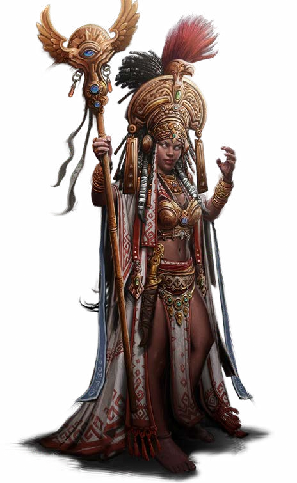

Alahazra was the iconic Oracle in PF1, replaced by the tengu Korakai in 2nd edition, but she's still here as a quick-build for Oracle, the Flame Augur. Described as "bride of the sun and prophet of the burning sands", Alahazra pretty cleanly represents one of the differences between Oracles in PF1 and 2. In PF2, the Oracle's Mystery and Curse are connected, so an oracle with the Flames mystery will always have the Curse of Engulfing Flames. In PF1, however, the two are separate. An oracle of the flames mystery could be blind, or she could be followed by fey who constantly play pranks on her. The curse is not linked in any way to the mystery, but it might give some plot hooks for the GM if the oracle wants to explore the source of her powers.
Notice how Alahazra's staff and headdress get more elaborate in Moreno's artwork before going back to a simpler design. I wonder if this is part of the reason some of Moreno's art was replaced, it was to do with characters being "off-model". Some of his other illustrations have details that are different from the PF1 designs, and which are then restored by later artists.
Alain, Iconic Cavalier


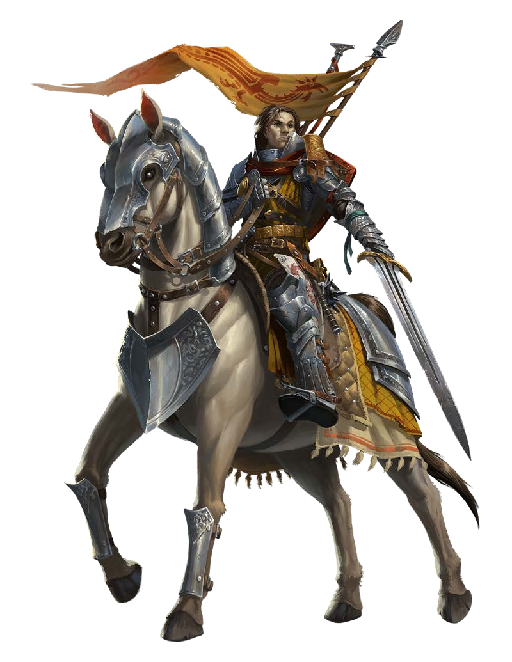
Alain and Donahan get a more dynamic pose, with the banner no longer being cut off by the edge of the page. The Moreno art looks kind of weird, with how Donahan has two front hooves up, but Alain looks kind of relaxed. I'm not sure what the line of action is supposed to be, if Donahan is about to rear or charge forward then Alain would be thrown backwards. The Remaster art looks a lot more... stable (no pun intended).
Donahan doesn't actually appear in any of the rulebooks in PF1, so PF2 already has two points in that regard. He does appear on some book covers, for Knights of Golarion and War of the Crown: The Twilight Child. Donahan's barding is more elaborate in the PF2 Advanced Player's Guide than it was in the few illustrations that exist of him from PF1, so like with Alahazra I wonder if that's why we got new Cavalier art for the remaster.
The Red Raven, Iconic Vigilante

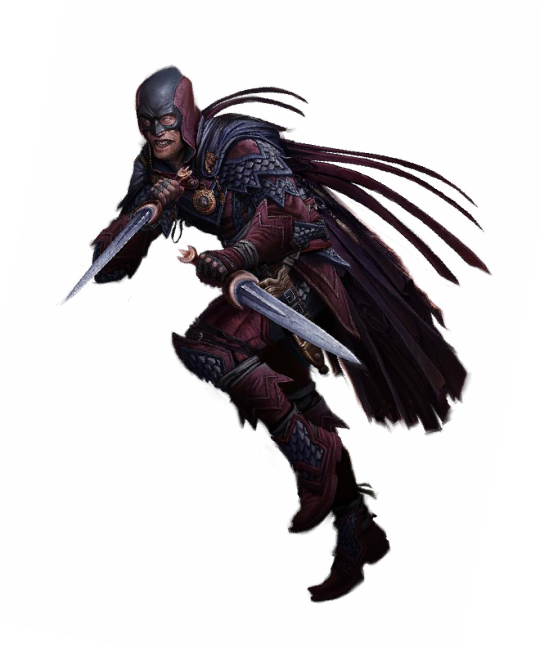
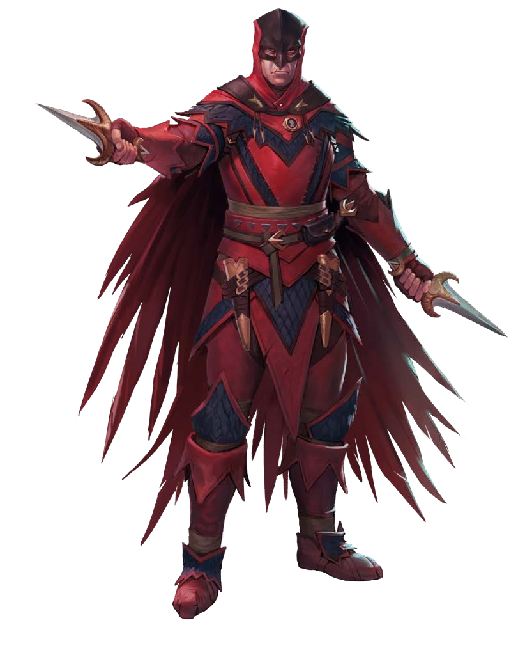
My boy has been redeemed! No shade on Moreno but like
come on!
You have to admit that the Red Raven art they did was so bad.
The new Vigilante in Player Core 2 brings back the colour, the detail on the daggers, and the specific styling of the cape. Definite improvement. The one thing I think Moreno had was the sort of skulky pose, but even then the Red Raven (despite being trained in Stealth) was always a bit more flamboyant. I can't find any illustrations of Aric in PF2 books, but perhaps I'm just not looking hard enough. Like I mentioned here, the Vigilante is a wordy archetype, so even though it has a double-page spread, having two illustrations would be really pushing it.

One more little addendum regarding the Red Raven: here's his first appearance, as seen in Pathfinder Module W3: Flight of the Red Raven. That is a module from back when Pathfinder was not its own roleplaying game, but a product line for Dungeons & Dragons 3.5. A lot of the Iconics were presented as pregenerated characters for such modules, but the Red Raven is unique, in that he was first introduced as an NPC. Since the Vigilante class was an invention of the Pathfinder Roleplaying Game that didn't appear until Ultimate Intrigue, the Red Raven is a rogue in his debut module, which seems like the most appropriate of 3.5's core classes.
Flight of the Red Raven came out in 2008, and Ultimate Intrigue in 2016, which marks the longest gap between a character being introduced and becoming an Iconic.

And the rest!
So here are illustrations from Player Core 2 that have been re-done, but aren't iconics. Not gonna have loads to say on these because there's lots of them and they're also not characters in the same way.
Chemist

The Chemist is one of three Quick Build alchemists in Core Rulebook (legacy) and Player Core 2 (remaster). I really wish we could split the difference here. There's lots of continuity between the two, but they're clearly not the same character. I prefer the detail on the outfit for the remaster Chemist, although the addition of bombs on her bandolier and at her waist makes her look more like a generalist than a specialist. The first one is just so much more colourful though.
Blessed One

Tough call here. It's not a competition and honestly I can't pick a favourite. I really love both of these. The pose and effect of the magic on the legacy art is amazing. The remaster art has a lot of motion and she's just so pretty.
Eldritch Archer
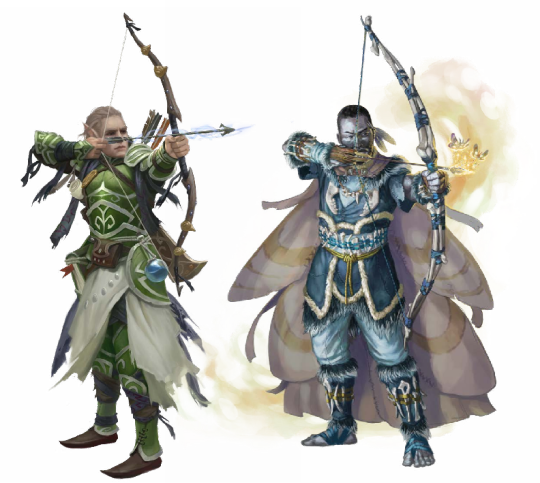
Lots of changes here. While the legacy eldritch archer (the design at least) was brought over from PF1, the remaster archer takes things in a bit of a different direction. I like the new outfit, and the addition of moth motifs.
Pirate

Another tough call. I will say, the artist who drew the legacy pirate (who might be Moreno, but I'm not sure) has a shading style that I really don't like. But I do like the design, a cocky tengu in a fabulous hat. The remaster pirate feels almost like a fusion of Lirianne and Jirelle, but with fewer accoutrements.
Snarecrafter
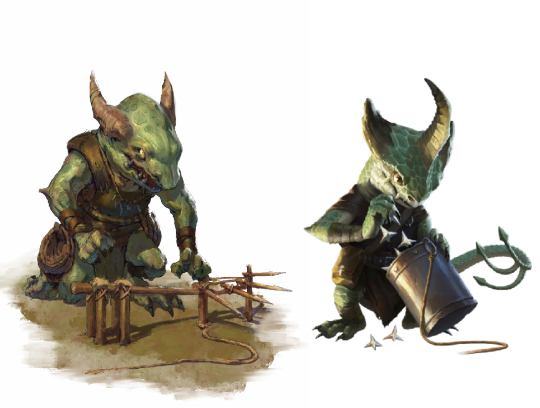
We've still got a kobold, although I like the addition of the central horn and triple tail tip to differentiate the remaster snarecrafter from other 'bolds. The lighting is really interesting on the remaster art actually, now that I look at it. It's like a low source, almost behind the subject. It's quite a striking effect.
I will say though, I dunno what snare you craft with a bucket of caltrops.

I feel like the pointèd sticks that the legacy crafter is working with would be more effective, plus I also think it shows off the sort of improvised nature of the snarecrafter's kit better than the shop-bought ingredients of the remaster bold.
Talisman Dabbler
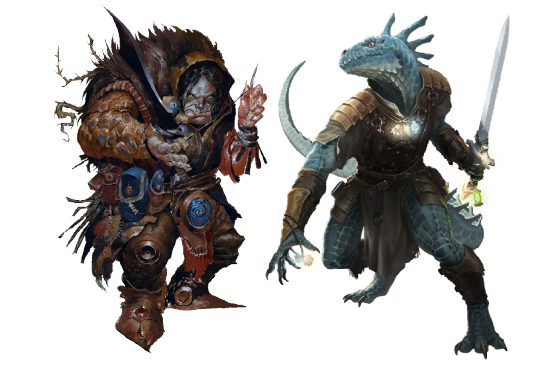
Two more strong contenders. The patchwork style of the legacy dabbler is neat, I feel like they've got lots of improvised bits and pieces. Like with the snarecrafter, the remaster dabbler doesn't really sell the idea that these are items the dabbler made that morning. I also enjoy that the legacy dabbler is in the process of dabbling, whereas the remaster dabbler is just an iruxi with lots of adornments.
Tough call.
Viking

Fairly sure this one (legacy) is a Moreno. The wild hair and sense of motion are really good, but there's something about the face that is unsettling, and not in the way I think the artist intended. I think they're also obviously a viking berserker rather than a standard viking. The remaster viking has a shield, and a bearded axe (and a cool coat) which are more iconic symbols of vikingdom.

[Part 1: Classes with Different Iconics] [Part 2: Core Classes] [Part 3: The Remaining PF2 Classes] [Part 4: Classes Who Got Demoted] [Part 5: Prestige Classes] [Part 6: Who's left?] [Update: Rivani and Linxia] [Update: Lirianne]
Divider from Saradika-graphics
5 notes
·
View notes
Text
Reblogging again because we've finally had a chance to play it - not a particularly organized session, but certainly a very fun one. I don't have any actual useful feedback, but I did get two hours well spent.
A little over a year ago, preparing to celebrate my birthday, I asked the guest list if they'd be interested in playing one of the games - Tiny Frog Wizards, Space Gerbils or Star-Spawned. The popular vote went to the frogs (renamed to toads in our native language for localization reasons).
...admittedly, I didn't fully realize the amount of translation work it would take. Since I hadn't had a party to play it with, I hadn't actually checked out the full rulebook beforehand and didn't realize it was 68 pages, but the people had spoken, and while Star-Spawned definitely would have been quicker, if harder, to translate, I set off to get the whole thing in my native language so even people without good knowledge of English could participate without me having to translate on the fly, and so I could prepare handouts.
And then we never played it. First there were too few people, then too many, then there were other things to do, and the printout of Tiny Frog Wizards stayed in my bag, forgotten.
Skip to this year. Grabbing the dusty pages and a handful of dice was almost an afterthought - I'd planned for frog pins as party favors, plus around six people said they were coming. And then I pitched the idea to the group, and everyone was wonderfully enthusiastic about it, even after I pulled out the massive heap of paper that the full rules were.
Over the year, I'd mostly forgotten everything, and messed some things up while guiding them through character creation, though it was thankfully only flavor stuff. Since most people were coming into the whole thing cold, we skipped over some of the rules (like opposition - I would have looked it up if it ever came to it, but it never did in the end), but that didn't make the experience any less enjoyable.
We played for about two hours before two people had to leave and the two new people didn't want to take over. In that time we managed to create the tiny frogs and play through a day of their adventures, consisting of three scenes. The amount of Misfortunes and Preparation Dice worked out perfectly - at least one frog spent all their Preparation Dice and one frog managed to get two Misfortunes by the time they decided it was time to just sleep the consequences of their actions off.
Though I took on the role of the GM, the game pretty much ran itself after a certain point. I certainly did very little to advance the narrative, just giving people the results of their spells and explaining exactly how they were (mis)interpreted.
Sometimes players wanted to do something the frogs were very unlikely to know about, but it was much funnier to come up with backstory and then have a slightly absurd spell backfire then it was to forbid them from doing a thing (sous vide flies, anyone?)
I guess it speaks to the age and general situation of the party that the most popular curse was "Depression". Some other fun ones were making a carnivore a vegetarian and aging some baby beavers up in body and soul, which I allowed, especially since the spell ended up saying nothing about their minds.
The frog heroes didn't set off to make each other's life difficult, but they ended up doing that nonetheless, which I think is marvelous. This game is not built for collaboration, and that makes for wonderful entertainment. Every attempt to fix things generally made the situation more and more convoluted until the party decided that "no, actually, that's exactly what we wanted to do" and moved on.
Anyway. Like I said, I do not have proper feedback, especially since I fully admit that what little problems we'd faced were probably due to poor translation work on my part and lack of preparation. but I do highly recommend checking it out - even without some of the randomized tables that would have made running a very improvised game easier, it was a blast both for me and for my players, and also for the audience who did their part by making artistic depictions of the developing scene.
If you would enjoy being a little menace, this is the game for you.
Oh, and if you're wondering what the frogs achieved in a single day. They organized a beaver cult. How a beaver cult of a super-beaver god would have a frog saint remains questionable; but it probably will, because one of the characters ended the day impaled on a spear (courtesy of another frog. Actually, two other frogs), with green absinthe rain (harmless to frogs) falling on him (summoned by himself), which would make for fantastic iconic imagery.

Tiny Frog Wizards playtest draft 0.3 is up. This is a major revision, re-working how spell parameters operate, introducing the concept of uncontrolled spells (and providing buckets of random tables to inspire their effects!), and replacing Paths of Power and Power Dice with a more spellcasting-centric – and, hopefully, easier to use – alternative.
It isn't quite where I wanted version 0.3 to be, but I've conveniently just suffered a hand injury which will require me to take a break from any major writing for the next few days, which I've chosen to interpret as the universe telling me to stop tinkering with it and get it in front of some other sets of eyes already.
You can find the latest draft at the link above, and the changelog under the cut. As always, comments, criticisism, and bizarre rants are welcome!
Changelog – Playtest Version 0.3
Note: All page numbers refer to the PDF vesion.
Two new interior illustrations by @amphibianaday.
Updated Credits & Acknowledgements (p. 3) to reflect reader-contributed random table entries.
Added a first pass at a glossary (p. 7).
Added a step-by-step outline of Tiny Frog Creation (p. 10).
Reworked Paths of Power and Power Dice into Preparation Dice and Foci (p. 12).
Parameters which are not assigned a die when making a casting roll (p. 20) now receive a default value of zero rather than 1.
Reworked parameter descriptions (p. 21) to allow for zero values.
Added rules for uncontrolled spells (p. 22) (i.e., spells with a Control value of zero).
Added explicit discussion of Potency (p. 23).
Rules for partial parameters (p. 23) updated to clarify that using less than a parameter's full value does not reduce the spell's Potency; added discussion of parameters for uncontrolled spells (above).
Clarified that spells which have gone haywire due to disruption (p. 25) no longer count against the number of spells you're currently concentrating no.
Reworked examples of direct opposition (p. 26).
Moved Recovery (p. 36) from a subsection of Misfortune to its own separate section, and addressed Preparation Dice (above) as well as Misfortune slots.
Added preliminary discussion and examples of Non-Player Characters (p. 37).
Updated Playing Without a GM (p. 39) to offer suggestions on how to incorporate the Supplementary Tables appendix (below).
Added notes on how to handle uncontrolled spells (above) to all nine Arcana writeups (p. 42).
Updated Alteration (p. 44) to use language consistent with other Arcana when discussing mundane actions with effective Potency ratings.
Updated Animation (p. 45) and Domination (p. 47) with discussion of open-ended commands like “obey me”.
Reworked discussion of what qualifies as a “phenomenon” in sidebar following Evocation (p. 48).
Clarified that Imprecations (p. 49) may not compel ongoing actions and slightly reworked how durations for spells of this Arcanum work.
Tightened up wording of Simulation (p. 50).
Updated optional rules for cantrips (p. 52) to reflect changes to how unrolled parameters work.
Additional examples of cooperative magic (p. 53).
Initial version of Supplementary Tables appendix (p. 58).
946 notes
·
View notes
Text
⚽🔥Dominate the Pitch with Our FIFA 25 Mastery Guide! 🎮🏆
Ready to take your FIFA skills to the next level? Whether you’re scoring epic goals or mastering defense, this guide will help you outplay your opponents and rise to the top. 🌟
🛠️ What You’ll Learn: ✅ Advanced gameplay mechanics for precise control ✅ Tactical formations to crush your rivals ✅ Pro tips for scoring and defending like a champ
✨ Step onto the field with confidence! Check out the full guide here: pixgamego.com/game-mastery/master-fifa-25
👉 Follow PixGameGo for more expert gaming guides, tips, and tricks!

1 note
·
View note
Text
PF2 Homebrew Advice: Monster Statistics
TL; DR Monster creation is an art; do not think you can make art by slapping some stuff together.
Now, Pathfinder 2e has a "top-down" approach to monster creation, meaning that they start with the approximate number rather than building to that number like PCs do. If a monster has a +22 Fortitude, it's not because "they're level 12, are master in Fort for a +6 and have a +4 Constitution modifier." They have a +22 because they just do.
My biggest piece of advice with monster creation is to just not worry about trying to make it "look" like it's consistent with the "bottom-up" approach. So what if the creature's Acrobatics and Athletics modifiers are both +18 when its Strength is +4 and its Dex is +3. If you get hung up on that, then you're gonna be proofreading constantly to make sure that it fits with this bottom-up approach and drive yourself mad and become exhausted. I know we say that "every +1 matters" in this game, but a +1 is not worth burning yourself out.
It doesn't have to be perfect, it just has to work!
For my second biggest piece of advice, ALWAYS give the monster a weak point. It doesn't have to be abysmal, it just needs to be noticeably worse. A creature that has no exploitable weak points simply becomes a game of attrition. That's part of why the barbazu was so notoriously deadly: it had no real exploitable weak points and it was STUPIDLY good at what it did. Give the monster a low Reflex, or Fortitude, or AC, or something. Don't make it good at everything!
So, lets get going.
To start, download this. I'm aware that these tables can be found in GM Core and the Gamemastery Guide, but I find it far more convenient to have an entire PDF that's dedicated exclusively to those monster creation tables, that way I don't have to memorize what page the tables are on in Gamemastery Guide, and I don't have to deal with the tables spilling over between pages in the GM Core.
Before we get into it, I just want to explain one thing:
Extreme Values
"At higher levels, give each creature more extreme statistics. Having one extreme statistic becomes typical around level 11. A creature at level 15 or higher typically has two extreme statistics, and one at level 20 or higher should have 3 or 4."
This is how it's recommended, and I agree with it wholeheartedly. Extreme values should be relatively sparse before level 11. And if they do come up, there should be a countermeasure to balance it out. Extreme values are very, VERY potent and should not be used haphazardly.
Now, let's start at the top:
Attribute Modifiers
Honestly? These are just there for completion purposes for if the creature is forced to make a roll it's not trained in. These numbers are just for flavor, as they dictate next to nothing in the grand scheme of things beyond the occasional "how smart/strong/etc. is this thing?" An Extreme value here is more for flavor than anything.
Perception
This is another statistic that doesn't really do a whole lot beyond beyond flavor and initiative. Perception is more of a thing for very unconventional tactics like Feinting and Hiding/Sneaking. Just pick a modifier that makes sense for the creature and be on with it. An Extreme Perception is a bit odd, but in my opinion should be saved for beings where a high perception is their gimmick, like something covered in eyes. Please ignore that the hyakume doesn't have extreme Perception; I still find this really silly.
Skills
Once again, these modifiers are mostly used for flavor, but they can also have a good chunk of combat capabilities. Generally, I give monster Athletics because that's a good general sense of how strong it is. A creature without Athletics should be something like a wizard or a fairy, where that doesn't make 100% sense. Similarly, Acrobatics should be put on a creature that is likely to have some kind of flight, since Maneuvering in Flight requires using Acrobatics. From there it's just a matter of flavor with what skills it has, though special mention should be given to Deception, Intimidation, and similar skills that can be used in combat to Feint or Demoralize. An Extreme value here can be very potent depending on the skill it's put in.
AC/Saving Throws/HP
Okay, now this is where a homebrewer can easily mess things up, because haphazard defense-creation can utterly devastate a party of PCs. All of these statistics are in a careful balancing act, and it should be treated with respect.
The most unoffensive creature you could ever make would have Moderate statistics in everything; everything about it is "meh." Now, if you want to raise something above Moderate, you have to take away from somewhere else. Sometimes this counterbalance to defense takes place in the offensive statistics, but that's not as common, in my opinion.
AC and HP are generally in some kind of balancing act. If you raise AC, you'll want to lower HP, and vice versa. However, High AC and Moderate HP (or vice versa) is generally okay; that tends to be where the Fighter lies, as it happens. Beyond that is when the counterbalancing needs to happen.
Saving throws are generally balanced against each other. My general rule of thumb is that a creature should have one High, one Moderate, and one Low save, as that creates a good range of "Do not target!" to "unideal to target" to "exploit it!" for casters or other non-conventional combatants. Now, if you want to use an Extreme value at, say, level 5, you would need to counterbalance it by lowering one of its other saves. The perfect example here is the forest troll. The troll has an Extreme Fortitude, but a Terrible Will; it effectively "stepped up" its Fort by "stepping down" its Will.
As another important note that I've even seen Paizo not follow at times: DO NOT GIVE MONSTERS ABILITIES THAT GENERALLY INCREASE THE DEGREE OF SUCCESS ON THEIR SAVE! Now, I'm not talking about an ability that increases its degree of success on saves vs. illusions or something. That's fine, as long as it makes sense. I'm referring to abilities that just say "if it succeeds on a Reflex save, it gets a critical success instead." We are not talking about mythic resilience right now. These abilities can shut down a lot of chip damage from basic saves, which makes the "feel" of the monster a lot more like an immovable object. If you're going to do that to, say, replicate a rogue, then just increase the value of its save by one category (usually High to Extreme). This is generally why Extreme values are more common at higher levels, because its to counteract with the PCs' "increase degree of success" abilities. This is also why monsters' HP is a lot higher than a PC's of that level: the lack of "increase degree of success" abilities makes the monster more susceptible to chip damage. THIS IS BY DESIGN! Increasing degree of success and a +3 to its save are two VERY different feels, and one feels more insurmountable than the other, and the last thing you want is for your players to feel like a combat is insurmountable.
HP/Fast Healing/Regeneration/Immunities/Resistance/Weakness
While HP is a counterbalance to AC, its primary counterbalances are fast healing/regeneration, resistances, and weaknesses. More weaknesses means that HP will generally go up, while higher fast healing/regen or resistances will mean HP should go down. There isn't a perfect way to figure out how to strike this balance, unfortunately. You just need to get a feel for it. Generally, a resistance to one narrow thing, like cold damage, shouldn't really affect HP a whole lot, but if its resistance to a good spread of damage types, then it should lower HP accordingly.
Now, I should make a particular note for Immunities, Resistances, and Weaknesses: never give something one of these three unless you can explain WHY! "It's resistant to fire because fire damage is very common" is NOT a good explanation. "It's resistant to cold because it regularly dwells in the cold depths of the ocean" IS a good explanation. Generally, a particular vulnerability to a specific material or something can be accepted because "the fey don't like cold iron because weird folklore stuff." It's not a perfect analogy, but I generally stand by that if I can't explain why an immunity, resistance, or weakness exists, then it shouldn't exist.
This is particularly noteworthy with fungi. For a while, I was really confused about why fungus creatures had a weakness to slashing, and I eventually discovered that when a mushroom is cut, it undergoes oxidation, which causes it to go bad. This is primarily why fungi have weakness to slashing.
Attack Bonus/Strike Damage
These are the two main offensive statistics, and they tend to go hand-in-hand. Now, High attack and High damage is the baseline for a fighter-type, while Moderate attack and High damage is usually where monks or champions lie. So the High attack bonus is generally reserved for creatures that are really good at attacking. Now, damage is actually where I see myself using the Extreme value most often, as Moderate attack and Extreme damage is very common for bruisers like the barbarian.
The agile trait goes a long way, so if I want to give a Strike agile, I generally counterbalance that by lowering its damage by one category. i.e. A dual-wielding fighter wielding a longsword and shortsword would have High attack and High damage with the longsword and High attack and Moderate damage with the shortsword.
Now, I use the recommended Strike damage dice/bonus kinda rarely. I more frequently look at the number in parentheses. Sometimes weapon choice dictates what kind of damage dice is dealt and makes things weird, so I usually go off of the number in parentheses to make it basically equivalent.
For the people who don't know statistics, for the purpose of calculating the number in parentheses, use the following values:
1d4=2.5
1d6=3.5
1d8=4.5
1d10=5.5
1d12=6.5
Those numbers are the average roll of those dice ([highest value + lowest value] / 2)
Now, if you don't hit the parenthetical numbers exactly, it's not the end of the world. If you were going for 36 damage and ended up at 37, that's basically the same thing. I generally say to try to stay within a margin of error of +/- 10% of the value you're gunning for. Which, yes, means that at lower levels the numbers are a lot tighter; that's kinda to be expected.
Spell DC and Spell Attack Rolls
Now, I also use this table for DCs of abilities like a dragon's breath attack or something. Now, this is a controversial take, but I NEVER use the spell attack roll modifiers in this table, because they are equal to the DC - 8, when they are usually equal to the DC - 10.
"But didn't you just say not to worry about the bottom-up stuff, and that it just has to work rather than be perfect?" Sure, but this table also fundamentally breaks the relationship between a DC and a modifier. A DC is definitionally the modifier + 10. The fact that it's a difference of 8 here is just...fundamentally against what the rules say.
"Then why do you say the modifier is wrong instead of the DC." Reverse engineering. The High DC at level 1 is 17, which is consistent with a spellcaster with a +4 in their casting attribute. Thus it's the +9 that's wrong, not the DC 17.
Anyway, not much to say here. But, if you want to use a DC for, say, an aura that requires being saved against every turn, use the Moderate DC, since the more dice that roll means the greater chance of failure.
And also, DEAR GOD USE EXTREME DC SPARINGLY! ESPECIALLY IF IT'S AN EXTREME SPELL DC!!! Extreme spell DCs mean that it is so so SO much more likely for a fail or crit fail to occur, and if you DO use Extreme spell DCs, the creature's other statistics should be lowered by a significant amount to counterbalance this. Seriously, use Extreme Spell DC with GREAT caution. Frankly, if I want a "higher than High spell DC," I tend to go with the Extreme value - 2, since that's just more manageable from the players' side.
Area Damage
Very similarly to the Strike Damage, you generally want to use the number in parentheses within a margin of error of +/- 10%. Now, the biggest thing here is that you want to make sure you lower the damage if it the ability imposes a condition, because I have seen a good number of creatures made by Paizo that DON'T do this. Funnily, drained actually makes the calculations a bit easier since it has a direct HP effect. Generally, if an area effect imposes drained, I count it as the drained value times the monster's level as damage toward the number in parentheses. It's not an exact value, but it's a good rule of thumb.
Now, a good example of a deceptively-balanced usage of this table is the brochmaw's Serve ability. On first glance, a two-action ability that deals 12d6 AND heals the monster for half that damage on a level 13 feels really really broken and badly designed. But, you have to take it in context. For one, the brochmaw is built around using Marinade to impose a penalty to Roast, then using Roast to impose a penalty to Serve. So it's very unlikely that the brochmaw will come out with the Serve if it's fighting intelligently. Likewise, Serve only targets one creature, and the brochmaw must have that creature already grabbed. And upon using Serve, the grab is ended. So unlike a dragon's breath attack, which has only one point of failure, Serve has three points of failure: the skewer Strike that has Improved Grab on it, the Athletics roll for Improved Grab, and finally the Fort save against Serve. All of this combined means that Serve deserves to have its potent damage alongside its healing capability.
3 notes
·
View notes
Text
//thinking about making a post with the stuff i've picked up about running events in my experience with this community + tumblr in general + general gamemastery, if anyone might be interested in that?
3 notes
·
View notes
Text
Pathfinder 2e Remaster Review - The GM Core - RPGBOT.News S3E94
On this RPGBOT.News, we look at the new GM Core for Pathfinder 2e. We look at what has and hasn't changed compared to the PF2 Gamemastery Guide and share our thoughts.

2 notes
·
View notes
Text
Mastering One Game Type Before Diversifying

SikkaGaming offers multiple game types. Don’t try to master all at once.
Pick one—like color prediction—and commit:
30 days of exclusive play
Log every outcome and mistake
Study the nuances of entry/exit
Mastery in one builds confidence and teaches you how to approach others later.
One focus = faster growth.
#SikkaGaming #FocusFirst #GameMastery #SpecializeBeforeExpand #OneStepMastery
0 notes